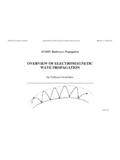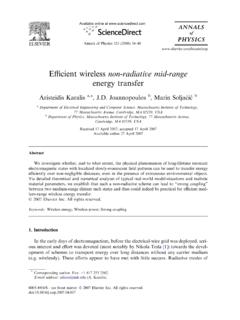Transcription of Tables of Chebyshev Impedance-Transforming Networks of …
1 Tables of Chebyshev Impedance-Transforming Networks of Low-Pass Filter Form GEORGE L. MATTHAEI, MEMBER, LEEE. Summary- Tables of element values are presented for lumped- low-passfilter structure. The maindifferencebetween element Chebyshevimpedance- transforming Networks , as are Tables thesestructuresandthose of conventional low-pass giving the Chebyshev passbandripple of each design. These circuits consist of aladdernetworkformed filters is that conventional low-pass filters have termi- using series inductances and shunt capacitances; they give a Chebyshev impedance matchbetweennating resistors of equal (or nearly equal) sizes a t each end. In the case of the filters discussed here, the termi- resistor terminations of arbitrary ratio (designs with resistor tenni- nation ratios from to 50 are tabulated). The responses of these nating resistors may be of radically different size, which Networks have moderately high attenuation at dc (the amount of means there will be a sizable reflection loss a t zero fre- attenuation depends on the termination ratio); their attenuation then quency.
2 As a result of this sizable attenuation LA^^ a t falls to a very low level in the Chebyshev operating band, and then zero frequency, rises steeply above the operating band in a manner typical of low- the transmission characteristics of passfilters. Designs havingoperating-bandfractionalbandwidths Chebyshev filters of this type have the form shown in rangingfrom to Impedance-Transforming Fig. 2. Sote that there is a band of Chebyshev ripple Networks can be realized in lumped-elementform for low-frequency extending from 0,' to w b ' , and that abovecob' the attenu- applications,and in semilumped-element form (such as corrugated waveguide) at microwave frequencies. ation rises steeply in a manner typical of low-pass filter structures. It should be noted that the attenuation GENERAL indicated in Fig. 2 is transducer attenuation expressed in UMEROUS papers have appeared on the design decibels; L e . , it is the ratio of the available power of the N of quarter-wave step-transformer structures.
3 Among these papersis one by Young,which con- tainstables of designs for quarter-wavetransformers generator to the power delivered to the load, expressed in db. Xs mentionedabove,thedesignstabulatedherein havingChebyshevtransmissioncharacteristi cs.'Since should prove useful for semilumped-element microwave theaccuratecalculation of suchtransformerdesigns structures, aswell as for lumped-element low-frequency can be very tedious, the existence of extensive Tables of structures. An example of a semilumped-element wave- step-transformerdesignshasprovedveryvalu able. guide structure is shown in Fig. 3. The structure shown Suchtransformersareextremely useful a t microwave is of the corrugated waveguide filter form's3 in which frequencies, but for applications involving frequencies steps or corrugations in the guide heightare used to much below 1000 \IC, the size of step transformers can simulate the shunt capacitors and series inductors of become impractically large.
4 The structures in Fig. 1. In Fig. 3, where the guide top Herein Tables of element values are presented for a andbottom wallscome close together,the effect is form of lumped-elementlow-passfilter structure that largely like that of a shunt capacitor (as is suggested b y has Impedance-Transforming properties similar to those the dashed-lined capacitors in the figure).Wherethe of a step transformer but which can be constructed in guide top and bottom walls go farapartto forma very compact form, even a t low frequencies. Though it groove, the effect is predominantly like that of a series is anticipated that this typeof Impedance-Transforming inductance (as is suggested by the dashed-line induct- structure will find greatestapplication a t frequencies ance in the figure). In this manner, semilumped-element below the microwave range, i t will beseen that the Impedance-Transforming structures canbe designed tabulated designs presented here will also be useful as from the prototype designs given herein.
5 A.. structure prototypes for the design of semilumped-elementim- such as that in Fig. 3 might prove desirable for wave- pedance- transforming Networks a t microwave frequen- guide applications, sayat L-band or below, where a con- cies. ventional step transformer might be larger than can be Fig. 1 shows the general formof the impedance -trans- accommodated for some given application. Such struc- tures can also find application a t higher frequencies for noted that the structureis of the form of a conventional use as structures for coupling t o magnetically tunable yttrium-iron-garnet ferrimagnetic resonators. Struc- Manuscript received February 12,1964. This research was s u p tures of the form in Fig. 3 have advantages for such ap- ported by the U. S. Army Electronics Research and Development Laboratory, Ft. Monmouth, X . J.,underContract DA 36-039- AMC-00084(E). S. B. Cohn, "Analysis of a wide-band waveguide filter," PROC.
6 The authoris with The Stanford Research Institute,Menlo Park, IRE, vol. 37, pp. 651-656; June, 1949. Calif. 3 G. L. Matthaei, Leo Young, and E. hl. T. Jones, "Design of Leo You;g, " Tables of cascaded homogeneous quarter-wave ?*licronaveFilters, impedance -MatchingNet works,and Coupling transformers, I R E TRANS. ON hlICROWAvE THEORY AND TECH- Structures,' Stanford Research Inst., Menlo Park, Calif., prepared NIQUE, vol. MTT-7, pp. 233-237; April, 1959. on SRI Project 3527, Contract DA 36-039 SC-87398, ch. 7; 1963. 939. 940 IEEEOF THE. PROCEEDINGS August plicationsbecausetheinductivesection at the low- impedance end of such a structure (forming L4 at the right end in Fig. 3) provides needed room for locating a ferrimagnetic resonator while at the same time giving theimpedancetransformationrequiredforobt aining tight coupling to the ferrimagnetic r e ~ o n a t o r . ~. ,R;+l G;, , RESISTANCE AT END n + l RESISTANCE ATEND 0 PARAMETERS.
7 OF THE ATTENUATION. (a> CHARACTERISTICS. The frequency scale of the Networks tabulated here has been normalized as indicated in Fig. 2 so that the --- G:.l~'Intl arithmetic mean-operating-band radian frequency, ,,,..+, Rh , CONDUCTANCE. AT END n +. +. I. CONDUCTANCEAT END 0. Wa' Wb'. (b) Wm' = 1 (1). 2. Fig. 1-Definition for normalized prototype element values for im- pedance-transformingnetworksof low-pass filterform.(The is scaled so that tabulated element valuesare normalized SO that go=l and h'= 1. [ S e e Fig. 2 .I). Wm' = 1. Herein the frequency variables and element values of the normalized prototype circuits will be primed to indi- I I cate that they are normalized, and corresponding un- primed quantities will be reserved for the same param- eters scaled to suit specific applications. With the nor- malization in ( 2 ) , and Wb' = 1 +-w2 ' ( 3. In most impedance -transformer applications, the pa- rameters of the normalized prototype circuit that will be of importancearetheimpedance or admittance transformation ratio r (see Fig.)))]
8 L), the fractional band- Fig. 2-Definition of response parameters for low-pass impedance - width w , and the db passband attenuation ripple Lar transforming filters. (The frequency scale for the tabulated proto- (see Fig. 2 ) . After a designer has determined the value type design is normalized so that urn'= 1, as indicated above.) of r , the minimum value of w , and the maximum allow- able value of Lar for his application, the next step is to determine the number n of reactive elements required in the circuit in order to meet these specifications. The required value of n can easily be determined with the aid of Tables 1 t o 5 (pp. 944-948). For example, suppose a designer desires an impedance transformer to give an r = 3 impedance ratio over the band from 500 to 1000. Mc with or smaller attenuation ripple ratio in the operating band. The required fractional bandwidth is given by IUPEDANCE-TRAUSFORUINC. CTRVCTYRE.
9 -w=-- fb - fa - 2 ( f b -fa). 1. (6). Fig, 3-A corrugated-waveguide structure for matching fm .fb + f a between guides of different heights. 4 G. L. Matthaei, et al., "Microwave Filters and Coupling Struc- tures,'' Stanford ResearchInst.,Menlo Park, Calif., Final Rept., SRI Project 3527, Contract DA 36-039 SC-87398, Sec. 111; February, 1%3. 1964 Xatthaei: Tables of Chebysheo impedance - transforming Networks 941. and gives which example for this - - 2(1000 - 500) = 1000 + 500. Thisvalue of fractionalbandwidth lies betweenthe is the frequency in the response in Fig. 2, whichcor- w= and w = values in Tables 1 to 5 , so the responds to w = O for the corresponding conventional w = value will be used. This will give an operating Chebyshev low-pass filter characteristic. hfaking use of bandwidth somewhat larger than is actually required, (8) and (9) and the equations for the attenuation of a which is often desirable.
10 However, if this is objection- conventionalChebyshev low-passfilter (see, for ex- able, the desired bandwidth can be achieved by inter- ample, Fig. 2 of Cohn5), we obtain polating between the values in Tables 1 to 5 in order to determinetherequiredvalue of n for w = and LA? db, and then interpolating between numbers in the element-value Tables (to be discussed later), to obtain a prototype with w= , r =3, and the given value of n. Reducing the bandwidth from to would mean that a smallervalue of LA? could be which applies in the stop bands O s w ' sua and achieved for given values of r and n. wb'<w'< a. In ( l l ) , Assuming that use of w = is satisfactory, we deter- mine the required value of n as follows. From table 1. (which is for n = 2 reactive elements), for w= and r = 3, we obtain LA?= db, which is too large. From table 2 (which is for n = 4 reactiveelements),for and n is thenumber of reactiveelements in theim- w = and r = 3, we obtain LA?






